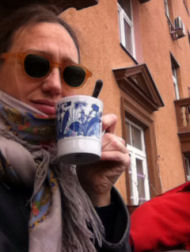|
|
MOSCOW
|
It’s a year since I was last in Moscow and I’m tormented by nostalgia. I lived there for ten years. It is a city that is far
from easy and spending even just a weekend there can be frightening. Yet you hold your ground and you let yourself be courted.
The finest in Moscow mojito is made at Strelka. Go towards the end of the afternoon, when even the cathedral commissioned
by El’cin looks amazing, its dome set ablaze by the setting sun. The barges will be sailing up the Moscova and the apartments
in front of you cost forty thousand euros per square metre.
Everyone will have recommended that you go to Caffè Puškin, and you really must not miss this restaurant that would have you
believe that it was built in the 19th century but which, actual fact, was still a hole in the ground on Tverskoj boulevard when
I first came to Moscow. It is absolutely fabulous, with its French-Russian cuisine and waiters with 19th century sideburns.
And of course you must not forget the bathrooms, those for the ladies at least, where all the washbasins are painted with blue
flowers in the style of the early 20th century.
Go far a walk in Moscow. The city is huge, but only by pounding its endless pavements an you really feel the grandeur of a
slightly sloping Red Square, which seems to accompany the Earth’s curve, or of the Sadovoye koltso, the “ring of gardens”,
an orbital road that runs around the whole centre of Moscow, where the roads are sixteen lanes wide.
Forget the Puškin Museum, the museum of modern art which is not a “must” for westerners (unless you are a fan of the Impressionists,
but – in that cases – you should go to the Musée d’Orsay), and visit the Tret'jakov gallery. The 19th was a century of moderate
artistic success all over the world, but not in Russia, where there is a blaze of fairies, knights, princesses and hermit monks
staring at the horizon made up of pink and blue horizons. The first time I saw it I was horrified, but then I fell in love with it.
Or the icons: mute for catholic Italians, until they tell you that Andrej Rublëv is the Russian Giotto, and when you’re standing in
front of his Trinity, you understand why.
Margherita Belgiojoso
|
|
|
|
|

|
|
|
|